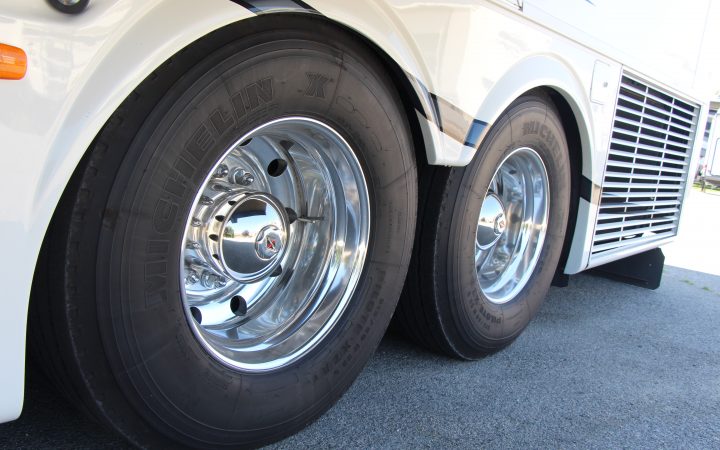
Passive steering on motorhome tag axles.
Many larger diesel pushers made today are equipped with tag axles. This is a third axle having single wheels at each side that resides behind the dual wheeled drive axle.
This feature increases the carrying capacity to help meet the heavier optioned coaches. They also can reduce the weight distributed on the drive axle such that lower air pressure can be used in the rear tire sets. This often contributes to a smoother, softer vehicle ride.
Tag Axle Wear
One of the issues with the additional axle is that it can reduce the turning radius slightly. This is caused by somewhat simulating a longer wheel base by moving the pivot point further back. Additionally, abnormal tread wear can result on the tag’s tires as they are forced to skid during a tight turning maneuver.
To overcome both of these issues, the RV chassis makers designed a driver-controlled pneumatic suspension solution. The axle’s air bag could be unloaded so the only weight during the turn would be that of the axle, or, aired fully up, lifting the axle tires from the ground. The method depended on the manufacturer, but either worked well.
Passive Solution
Commercial vehicles like Prevost and MCI passenger buses adapted another solution and have used it for years. They used a steerable tag axle. The most common being a passive steer type. Basically, the wheels steer in the needed direction controlled by the vehicle’s turning angle configuration.
In 2014 or so, RV makers and their chassis suppliers started offering passive steering tag axles. Perhaps they introduced it to one-up their competition. In my opinion, the air up or unload was all that was needed in the RV application.
So, why is this feature needed in the commercial bus industry but perhaps not beneficial in the RV application? Tour buses are engaged constantly in turning within a tight radius many times each day with the likes of hotel parking lots, etc. Motorhomes are not constantly challenged with this requirement and can turn as tight as a passive steer axle using the air-up feature. A steerable tag transfers the rear pivot point to the center of the drive axle. An aired up or unloaded tag also transfers the pivot to the drive axle center. There is no tighter a radius turn with either. Any statement otherwise is just smoke and mirrors.
But, like many new features being offered today, there are buyers that insist on such technology and those who do not. However, in most cases steerable tag axles either come with a unit or don’t — it’s another item to add to your list of considerations when shopping for a new RV.
What is your preference?
Peter Mercer – Clearing Up the Tag Axle Smoke and Mirror Myths





